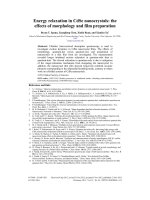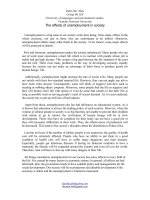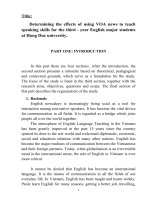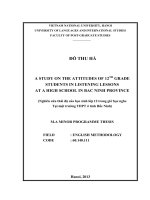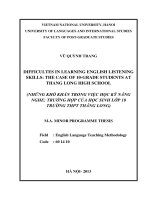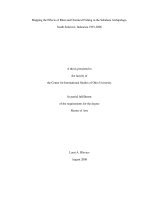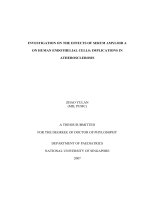The effects of using sense relations in learning english vocabulary of 9th grade students in a secondary school in hanoi
Bạn đang xem bản rút gọn của tài liệu. Xem và tải ngay bản đầy đủ của tài liệu tại đây (559.02 KB, 70 trang )
VIET NAM NATIONAL UNIVERSITY, HA NOI
UNIVERSITY OF LANGUAGES & INTERNATIONAL STUDIES
FACULTY OF POST – GRADUATE STUDIES
*****************
DƯƠNG THỊ HƯƠNG
THE EFFECTS OF USING SENSE RELATIONS ON LEARNING
ENGLISH VOCABULARY OF 9
TH
GRADE STUDENTS IN A SECONDARY
SCHOOL IN HANOI
Ảnh hưởng của việc sử dụng mối quan hệ về nghĩa vào việc học từ vựng của
học sinh lớp 9 tại một trường THCS ở Hà Nội
M.A. MINOR PROGRAMME THESIS
Field: English Teaching Methodology
Code: 8140231.01
Hanoi – 2018
VIET NAM NATIONAL UNIVERSITY, HA NOI
UNIVERSITY OF LANGUAGES & INTERNATIONAL STUDIES
FACULTY OF POST – GRADUATE STUDIES
*****************
DƯƠNG THỊ HƯƠNG
THE EFFECTS OF USING SENSE RELATIONS ON LEARNING
ENGLISH VOCABULARY OF 9
TH
GRADE STUDENTS IN A SECONDARY
SCHOOL IN HANOI
Ảnh hưởng của việc sử dụng mối quan hệ về nghĩa vào việc học từ vựng của
học sinh lớp 9 tại một trường THCS ở Hà Nội
M.A. MINOR PROGRAMME THESIS
Field: English Teaching Methodology
Code: 8140231.01
Supervisor: Dr. Trần Thị Thu Hiền
Hanoi – 2018
DECLARATION
I hereby certify that the thesis entitled “The effects of using sense relations
on learning English vocabulary of 9
th
grade students in a secondary school in
Hanoi” is the result of my own research for the Degree of Master at the University
of Languages and International Studies, Vietnam National University, and this thesis
has not been submitted for any other degrees.
Ha Noi, August 2018
Dương Thị Hương
i
ACKNOWLEDGEMENTS
I would like to send my sincere gratitude to Dr. Tran Thị Thu Hien for
helping me finish this study. This paper would not be finished without her sincere
patience and encouraging guidance. Her patience and helpful advice helped me
confidently express my ideas into this paper.
Furthermore, I would like to express my sincere thanks to all my lecturers at
the Faculty of Post-graduate Studies, University of Languages and International
Studies for their valuable lectures which have helped me a great deal in gaining a
lot of theoretical as well as practical knowledge.
My special thanks are for the principal and teachers at a secondary school in
Hanoi that helped me carry out the study and for 29 grade-9 students who took part
in the experimental teaching by using sense relations.
Finally, I would like to express my deep gratitude and love to my beloved
parents, my brothers, my husband and my friends who supported and encouraged
me to complete this thesis.
ii
ABSTRACT
Vietnamese students often face difficulties in learning vocabulary. They fail
to remember words and to recall words when necessary because of their learning
habits and learning strategies. Based on literature review, it is found that sense
relations can have positive effects on vocabulary learning. This thesis is entitled
“The effects of using sense relations on learning English vocabulary of 9
th
grade students in a secondary school in Hanoi” which aims to find out the
improvement of the use of sense relations in teaching vocabulary. This research was
a quantitative and qualitative method. To obtain the data, test, the questionnaire and
the interview were used. In selecting the sample, the writer used purposive
sampling. The sample was the students in class 9A1 of a secondary school which
consisted of 29 students. The result of test showed that using sense relations could
improve the students‘ ability in English vocabulary mastery. In addition, based on
the analysis of the interview, the English teacher gave some suggestions for the
application of sense relations in teaching vocabulary. It can be concluded that sense
relations have a positive effect on students‘ vocabulary acquisition.
iii
LIST OF ABBREVIATIONS
ELT
: English Language Teaching
Q
: Question
SR
: Sense Relations
iv
LIST OF FIGURES, CHARTS AND TABLES
Figure 1.1: Example of hyponymy relation
Chart 3.1: Frequency Distribution of Pre-test
Chart 3.2: Frequency Distribution of Post-test
Table 2.1: Summary of the questions in the students‘ questionnaire
Table 2.2 : Data collection procedure
Table 3.1: Students‘ habits of vocabulary learning at home
v
TABLE OF CONTENTS
DECLARATION .........................................................................................................
ACKNOWLEDGEMENTS ........................................................................................
ABSTRACT ..............................................................................................................
LIST OF ABBREVIATIONS ....................................................................................
LIST OF FIGURES, CHARTS AND TABLES .........................................................
PART ONE: INTRODUCTION ..........................................................................
1.
Rationale for the study ........................................
2.
Aims and objectives of the study ........................
3.
Research Questions .............................................
4.
Scope of the study ...............................................
5.
Significance of the study ....................................
6.
Methods of the study ..........................................
7.
Organization of the study ....................................
PART 2: DEVELOPMENT ..................................................................................
CHAPTER 1: LITERATURE REVIEW .........................................................
1.1.
Vocabulary .......................
1.1.1. Definition ...................................................................................................
1.1.2. The importance of vocabulary ...................................................................
1.1.3. Types of vocabulary ...................................................................................
1.2.
Vocabulary teaching ........
1.2.1. Vocabulary teaching process ......................................................................
1.2.2. Techniques in teaching vocabulary ............................................................
1.2.2.1. Visual techniques ....................................................................................
1.2.2.2. Verbal techniques ....................................................................................
1.3.
Vocabulary learning .......
1.3.1. Vocabulary acquisition process ................................................................
1.3.2. Vocabulary learning strategies .................................................................
vi
1.4. Sense relations....................................................................................... 13
1.4.1. Types of sense relations.......................................................................... 13
1.4.1.1. Synonymy............................................................................................ 13
1.4.1.2. Antonymy............................................................................................ 13
1.4.1.3. Hyponymy........................................................................................... 14
1.4.1.4. Polysemy and homonymy.................................................................... 15
1.4.1.5. Meronymy............................................................................................ 16
1.4.1.6. Attributive relation............................................................................... 17
1.4.1.7. Instrumental relation............................................................................ 17
1.4.1.8. Place relation........................................................................................ 17
1.4.1.9. Other kinds of sense relations.............................................................. 17
1.4.2. Advantages of using sense relations in teaching and learning vocabulary17
1.5. Previous studies..................................................................................... 18
1.6. Chapter summary................................................................................. 19
CHAPTER 2: METHODOLOGY................................................................. 21
2.1. The research setting................................................................................. 21
2.1.1. Research site........................................................................................... 21
2.1.2. English textbooks.................................................................................... 21
2.2. Participants................................................................................................ 22
2.2.1. The teacher.............................................................................................. 22
2.2.2. Students................................................................................................... 22
2.3. Methods of the study................................................................................ 22
2.3.1. Action research....................................................................................... 21
2.3.2. Action plan.............................................................................................. 21
2.4. Data collection instruments..................................................................... 27
2.4.1. The tests.................................................................................................. 27
2.4.2. The questionnaire.................................................................................... 28
2.4.3. The interviews......................................................................................... 30
2.5. Data collection procedure.......................................................................... 31
2.6. Chapter summary....................................................................................... 31
vii
CHAPTER 3: FINDINGS AND DISCUSSION............................................ 32
3.1. The tests.................................................................................................... 32
3. 2. The questionnaire.................................................................................... 34
3. 3. The interviews......................................................................................... 36
3.3.1. The pre-interview.................................................................................... 36
3.3.2. The post-interview.................................................................................. 37
3.4. Chapter summary.................................................................................... 40
PART THREE: CONCLUSION....................................................................... 41
1. Recapitulation............................................................................................... 41
2. Pedagogical implications.............................................................................. 41
3. Limitations of the study................................................................................ 43
4. Suggestions for further studies...................................................................... 44
REFERENCES
.......
.......................................................................................................
APPENDICES ...............................................................................................................
viii
PART ONE: INTRODUCTION
1. Rationale for the study
In the modern world, people need to know more than one language to communicate
with others. Vocabulary plays an important role in learning any foreign language
because it can encourage students to improve four basic skills such as listening,
speaking, reading and writing. Language ability of learners will be improved overall
by vocabulary improvement (Linse, 2006). However, many learners face a lot of
challenges to learn and memorize new words. Therefore, language teachers are
searching for useful methods which can be used to help their students acquire
vocabulary well. In fact, there are various techniques and methods that can be used
to present vocabulary; however, there are some factors that should be taken into
consideration concerning the manner of presenting new lexical items. Furthermore,
if teachers want learners to retain new words, they should present them in suitable
contexts, practice them, and revise them in order that their learners cannot forget
them. As a result, learning vocabulary items depends on the way they are presented
and the way they are revised.
It is clear that finding out the suitable techniques of vocabulary teaching plays a
crucial role in helping students acquire vocabulary. Therefore, teaching vocabulary
has become one of the common research subjects in English language studies
recently. These days, the academics are comparing the previous methods of teaching
vocabulary with the latest ones to find more effective ways. One of these popular
comparisons has been made in the context of representing a new vocabulary item in
semantically related and semantically unrelated sets. Moreover, some studies
indicate that learning vocabulary through using sense relations has become crucially
important for foreign language learners because teachers can easily engage their
students in the class and help them remember new words quickly. As an English
teacher, the researcher realizes that teachers often have difficulty in teaching their
students to learn vocabulary effectively. The fact is that the vocabulary acquisition
of most Vietnamese students is quite low. The reason for this
1
could be that in Vietnam, vocabulary is learnt with traditional methods such as
writing new words in a notebook and learning them by heart, reading new words
several times. This can make students become bored and some students find it more
difficult to remember words especially if they are young learners.
Generally, teaching students to master vocabulary is not an easy task for all
language teachers. Therefore, the researcher thinks that using sense relations such as
synonyms, hyponyms, etc., is one of the effective tools for teaching English in
particular and teaching foreign languages in general. This can help learners easily
remember the words that they learnt. Moreover, using sense relations could make
lessons become more interesting and engaging. From the reasons above, the author
would like to carry out a research about ―the effects of using sense relations on
vocabulary learning‖.
2. Aims and objectives of the study
The study mainly aims at examining whether sense relations can improve students‘
th
English vocabulary knowledge at the 9 grade students at a secondary school. Its
inter-related objectives are:
- Determining whether sense relations can improve students‘ English vocabulary for
th
the 9 grade students at a secondary school or not
- Providing some possible suggestions on the use of sense relations in teaching
vocabulary
3. Research Questions
In this study, the researcher attempts to answer the following questions:
Do sense relations improve students‘ English vocabulary at the 9
students at a secondary school?
th
grade
What are possible suggestions on the use of sense relations in teaching
vocabulary?
4. Scope of the study
The study was conducted at a secondary school, Thach That district, Hanoi city. It
only focused on investigating whether sense relations improve the 9
th
grade
students‘ English vocabulary knowledge. Other research aiming at studying on the
2
effects of sense relations on other aspects of English learning and other types of
students in other institutions are out of the scope of the study.
5. Significance of the study
The study aims at determining if sense relations improve learners‘ English
vocabulary. Therefore, it can be useful for both theoretical and practical
contributions. In terms of theoretical contributions, this thesis will be served as a
reliable and useful reference material about using sense relations in teaching
vocabulary for other readers and researchers in their further studies on related
subjects. For the practical contributions, the findings and results of the research are
significant to both teachers and students because using sense relations helps learners
acquire vocabulary effectively and easily. This is one of the most useful techniques
that teachers should make use of to facilitate their students‘ learning.
6. Methods of the study
To achieve the aims of the study, action research was applied. The study was
conducted in 8 weeks. In the first week, students‘ questionnaire and the teacher‘s
pre-interview were used to investigate their opinions on ways of vocabulary
learning and teaching. At the same time, a pre-test was given to 29 students of a
class to find out the students‘ vocabulary knowledge before the experiment was
conducted. Then, the researcher asked the teacher to implement sense relations to
teach vocabulary from week 2 to week 7. After that, in the last week, a post-test was
delivered to the same population to measure the improvement of the students‘
vocabulary after the treatment. After the post-test, a post-interview was carried out
with the teacher who participated in the experimental teaching in order to
investigate the difficulties she had in applying sense relations to teach vocabulary as
well as suggestions for the use of sense relations to teach vocabulary.
7. Organization of the study
The study is divided into three parts as follows:
Part 1: Introduction
This part is a brief description of the research including the rationale for
conducting the research, the aims of the study, research questions, scope
3
of the study, significance of the study, and outline of the study
Part 2: Development
Chapter 1: Literature review
This chapter deals with the theoretical framework of the subject and
related studies.
Chapter 2: Methodology
This chapter presents the research context and methodology of the study
including the context, the subject, data collection instruments, data
collection procedure and data analysis.
Chapter 3: Findings and discussions
This chapter presents the major findings and discussions from the
students‘ pre-test and post-test, the questionnaire and interviews.
Part 3: Conclusion
This part provides a summary of the key findings, implications,
limitations, and future suggestions for further study.
4
PART 2: DEVELOPMENT
CHAPTER 1: LITERATURE REVIEW
Part 1 presented the overview of the study, its aim and structure. To provide a
background of the study, this part describes a theoretical framework for designing
and analyzing data.
1.1.
Vocabulary
1.1.1. Definition
In everyday life, we say something, express our feelings and tell what we want to
say. All the things need the words, and these words are called vocabulary.
Vocabulary plays an important role in improving our skills in English. It becomes
one of aspects for improving communication skill. Without having enough words,
communication will end up in unpleasant situation and make the students difficult to
continue their sentences or ideas. Therefore, it is highly essential for English
teachers to help their students master vocabulary.
There are a variety of definitions of vocabulary. Pyles (1970) asserts that vocabulary
is the focus of language with its sounds and meaning, which interlock to allow us to
communicate with one another. What is more, vocabulary can be defined as words
in a specific language or freestanding items of language that have meanings
(McCarthy, 1990). Ur (1996) defines vocabulary roughly as ―the words we teach
in the foreign language‖. Vocabulary was one of language components, which
supports the teaching and learning of the four language skills of reading, listening,
speaking and writing. As the language component, vocabulary must be taught in a
proper way. Moreover, vocabulary can be broadly defined as knowledge of words
and word meanings (Lehr et al., 2004). Lehr and his colleagues state that vocabulary
is more sophisticated than this definition. Firstly, words not only come in oral forms
but also in print forms. Secondly, vocabulary also comes in two forms: receptive
and productive. Receptive words refer to words that can be recognized in reading
and listening. Productive words are words used in speaking and writing
5
(Lehr et.al., 2004).
As discussed above, vocabulary can be seen in many different ways. In this study,
vocabulary refers to the words, compounds and idioms in a language that can be
used to conveyed and received information in oral and written communication.
1.1.2. The importance of vocabulary
When it comes to the importance of vocabulary, Krashen (1989) shows that ―a
large vocabulary is, of course, essential for mastery of a language‖ as ―without
vocabulary, nothing can be conveyed‖ (Wilkins, 1972). Rubin and Thompson (1994)
demonstrate that ―one cannot speak, understand, read or write a foreign language
without knowing a lot of words.‖. Nguyen and Khuat (2003) also assert that
vocabulary knowledge plays an important role in learning a foreign language. In
fact, vocabulary is a means to help learners communicate well. Thus, they should
have an adequate numbers of words to support communication. It is an important
component of language instruction. In order that learners can communicate with
other people well in a certain foreign language, they should acquire an adequate
number of words and know how to use them correctly. When referring to the
importance of vocabulary in communication, Della and Hocking (1992) also state
that with a little grammar, learners can have a little smooth communication, but
without vocabulary, it is difficult for others to understand the information that they
want to express. Therefore, knowing words and how to use them in suitable contexts
are more important than grammar rules. "When students travel, they do not carry
grammar books, they carry dictionaries"(Krashen as cited in Lewis, 1993:25). As
discussed above, vocabulary plays a crucial role in language learning to sustain
other language skills, namely listening, speaking, reading and writing.
1.1.3. Types of vocabulary
According to Montgomery (2007), there are four main kinds of vocabulary:
listening vocabulary referring to words we hear and understand when listening to a
speech, speaking vocabulary including all words we use in our everyday
conversations, writing vocabulary consisting of all words we use in writing, and
6
reading vocabulary involving all words in print that we recognize or figure out.
According to Elfreida and Michael (2005), vocabulary can be presented in different
types according to different purposes. In general, vocabulary is defined as the
knowledge of word meaning in its different forms (oral or print) or types (receptive
or productive). Oral vocabulary includes the words used in speaking or oral reading,
while print vocabulary refers to the words recognized or used in writing or silent
reading. Moreover, receptivity and productivity are another criterion of vocabulary
distinction. Receptive vocabulary consists of words whose meaning is known when
we listen or read. Meanwhile, productive vocabulary refers to set of words used in
speaking and writing. Although vocabulary is differently defined, it commonly
refers to the knowledge of word and its meaning.
1.2.
Vocabulary teaching
1.2.1. Vocabulary teaching process
In general, vocabulary is a matter of remembering, unlike e.g. learning grammar,
which is a system based mainly on rules. Thornbury (2004) states that in order to
teach vocabulary effectively as possible, it is important to know, how words are
remembered and stored in students‘ minds and how long term memory is organized.
Some researchers agree that vocabulary is stored in the mind in a highly organized
and complex web-like system, the so-called ‗mental lexicon‘. In the mental lexicon,
words are stored, categorized and interconnected in many ways, according to their
features such as meaning, form, collocation, syntactic properties, cultural
background. As a result, a word being retrieved is looked up through several
pathways at once, which is extremely economical in terms of time needed (Gairns
and Redman: 1992; McCarthy: 1992; Thornbury: 2004). One of the most important
roles of language teachers is to help their students find the easiest way of conveying
new information into the already existing system of the mental lexicon (Thornbury
2004: 93). Besides, students need to acquire the ability to store the information for
as long as possible.
Teaching English is not easy task to do because it needs teachers who are aware of
7
the importance of target language aspects. Teaching vocabulary is regarded as an
important step in the process of teaching foreign languages.
Sökmen (1997) listed some key principles of teaching vocabulary such as building a
large sight of vocabulary, integrating new words with old one, providing a number
of encounters with a word, promoting deep level of processing, facilitating imaging,
making new word "real" by connecting them to the student's word in some way,
using various techniques and encouraging independent learning strategies. Thus,
teachers need to meet almost all the principles so as to get effective results.
According to Marzano (2004), vocabulary teaching process can be organized into
six instructional steps. The first three steps are used to introduce a new vocabulary
term to students. The last three steps provide different ways that students should
experience over time to help them shape their understanding of the terms. In this
study, teaching vocabulary by implementing sense relations also follows these steps.
The six steps are as follows:
Step 1: Explain—Provide a student-friendly description, explanation, or example
of the new term.
Step 2: Restate—Ask students to restate the description, explanation, or example in
their own words.
Step 3: Show—Ask students to construct a picture, symbol, or graphic
representation of the term.
Step 4: Discuss—Engage students periodically in structured vocabulary discussions
that help them add to their knowledge of the terms in their vocabulary notebooks.
Step 5: Refine and reflect—Periodically ask students to return to their notebooks
to discuss and refine entries.
Step 6: Apply in Learning Games—Involve students periodically in games that
allow them to play with terms.
1.2.2. Techniques in teaching vocabulary
There are a variety of techniques that can be used in teaching vocabulary and
teachers need to know how to use various techniques in presenting vocabulary to
8
their learners. Gairns & Redman (1986) mentioned the most common ways of
presenting and explaining meanings of the new words. These techniques are divided
into two groups: visual techniques and verbal techniques.
1.2.2.1. Visual techniques
Visual techniques consist of two main techniques which are visuals, mime and
gesture.
a. Visuals
Visuals include flashcards, photographs, blackboard drawings, wall charts and
realia (Gairns
and Redman:73). Moreover, these techniques are applied in
conveying meanings, and especially they are valuable for teaching tangible items of
vocabulary such as food or furniture.
b. Mime and gestures
These techniques are used additionally as another way of conveying meanings. For
instance, when teachers explain an action like smoking, it is better to use mime than
draw a picture. However, using mime and gestures is not always easy because the
teacher should be a good ―actor‖ . Sometimes, to have our presentation more
precise, the mimes can be accompanied by blackboard drawings or showing pictures
(Gairns and Redman, 1986: 74).
1.2.2.2. Verbal techniques
Verbal techniques are techniques that are presented orally or that have a written
form. Ur (1991: 64) stated that ―on the whole, definition, synonym and description
tend to be most popular, perhaps because they are most obvious and conventional.‖
In this section, techniques such as using sense relations (synonyms, antonyms),
definitions, collocations and translation are discussed as common verbal
presentation techniques.
a. Synonyms
This technique can be used with students either at lower or at higher levels (Gairns
and Redman, 1986: 74). The explanation for low level learners should be shorter
and simpler than that for high level learners.
9
b. Antonyms
As with synonyms, antonyms are alternative techniques in presenting words and
their meaning, so learners can grasp the sense of such items. For example, when
presenting the meaning of the word "big", we can illustrate it by contrasting it with
"small". Nevertheless, it is necessary to illustrate the contexts in which these items
are took place.
c. Definition
Definition is another important technique in conveying meaning. Harmer (1991:
162) pointed out that giving definitions when introducing new words might be very
challenging for students at lower levels, while it can be very useful for more
intermediate learners. Gairns and Redman (1986: 74) advised that by using
definitions the teacher should present a new word in context in order to avoid
possible misunderstanding.
d. Collocations
Another technique used when presenting new words is teaching words with their
collocations. Generally, we should not teach individual words in the classroom. As
Hoey (1991) in Lewis (2000: 224) informed, ―learning individual words is
relatively inefficient―. Thus, for instance, when presenting the word
“disappointed”, the teacher should teach a common collocation “bitterly” .
Furthermore, Lewis (Lewis, 2004: 14) believes that it is good for students to show
them ―how words are actually used and how they collocate‖, rather than explain
their meaning.
e. Translation
According to Catford (1985), translation is defined as ―an operation performed on
languages, a process of substituting a text in one language for a text in another‖.
Although translation does not make learners have the motivation to think about
word meaning (Cameron, 2001), it could be an effective technique for teachers in
some situations, such as when dealing with incidental vocabulary (Thornbury,
2002), checking students‘ comprehension, and pointing out similarities or
10
differences between first and second language, when these are likely to cause errors
(Takač, 2008). There are always some words that need to be translated and this
technique can save a lot of time. However, teachers need to consider that translation
should not prevail over other presentation techniques when teaching vocabulary in
the classroom.
1.3.
Vocabulary learning
1.3.1. Vocabulary acquisition process
Acquiring the vocabulary of our first language is not an easy task. However,
acquiring the vocabulary of a second language especially if the second language
learners are young is even more complicated. Young learners of a second language
are still building up their first language vocabulary, and this development is closely
tied up with their conceptual development. In fact, young language learners begin
the task of first language acquisition without the cognitive maturity or
metalinguistic awareness that older second language learners have. Although young
second language learners have begun to develop these characteristics, they still have
far to go in these areas, as well as in the area of world knowledge, before they reach
the levels already attained by adults. Therefore, in planning and teaching a foreign
language, we need to bear in mind this first language background to know what will
work and what may be too difficult for children. Vocabulary development is not just
about learning words, it is also about learning more about those words, about
learning formulaic phrases or chunks, or finding words inside them. Learning words
is not an easy task that is done and finished in a short period of time. It is complex
since learning words is a cyclical process of meeting new words, followed by
meeting those words again and again, each time extending knowledge of what the
words mean and how they are used in the foreign language. As Cameron points out
―every time children meet familiar words, they have changed and will bring new
first language and conceptual knowledge to the vocabulary‖ (Cameron, 2001:74).
According to Locke (1993), the acquisition of the word meanings takes much longer
than the acquisition of the spoken form of the words so children use the words in
11
their speech long before they have a full understanding of them. The vocabulary
development is a continuous process in which, children do not only add new words
to their existing vocabulary bank but also build up knowledge about words they
already know partially. Learning a word requires a long time and plenty of exposure
to the word used in different situations.
1.3.2. Vocabulary learning strategies
When it comes to vocabulary learning, Nation develops a general classification of
vocabulary learning strategies (Nation, 2001). The first one is planning vocabulary
learning, i.e. to choose words. Learners should know what their vocabulary goals
are and choose what vocabulary to focus on in terms of their selected goals.
Moreover, they should also have a clear strategy for deciding what vocabulary to
focus on and where to find this vocabulary. When learning vocabulary, choosing
certain aspects of a word (usually meaning but for listening and writing, the form of
word is also essential to pay attention to) to focus on and using various strategies
can make the learning process become better. The second vocabulary learning
strategy is sources. In order to cope with new vocabulary when it occurs and to
learn unfamiliar vocabulary, learners have to be able to get information about the
words. Analyzing word parts is a useful strategy, because being familiar with the
stems and affixes can provide useful for seeing connections between related words,
checking guesses from context, strengthening form and meaning connections, and in
some cases working out the meaning of a word. Meanwhile, consulting reference
sources properly and using parallels can also be helpful in vocabulary acquisition.
The third vocabulary learning strategy is processes, which is establishing
vocabulary knowledge. It involves ways of remembering vocabulary and making it
available for use. Noticing is a widely used way of recording vocabulary, and it can
be a very useful first step towards deeper processing of words. Retrieving
strengthens the connection between the cue and the retrieved knowledge. It is
superior to noticing. Generating is the production of the word. It is the further step
of learning process.
12
1.4.
Sense relations
Lexical semantic relations or ―sense relations‖ show the relationship between
words and their meanings (one type of meaning with each other). According to the
meaning we can differentiate between two distinctions: the first is the ―reference‖
which shows the external meaning of a word (what the word refers to in the
physical world), while the other is the ―sense‖ that indicates the internal meaning
of a word (its content).
1.4.1. Types of sense relations
Sense relations show the relationship between words and their meaning. According
to Kess (1992), Miller (1996) and Cruse (2004), sense relations can indicate many
kinds of relations as follows:
1.4.1.1. Synonymy
Synonymy refers to a group of words that share a general sense and so may be
interchangeable in a limited number of contexts. As Palmer suggested in (1976:88)
―synonymy refers to the sameness of meaning, so we say for the set of words
having the same meaning or they are synonyms of one another. For example, we can
say that pairs of words such as ―alter/ change, big/ large, rich/ wealthy‖ are
synonyms because they have the same meaning. Saeed (1997:65) stated that
―synonyms are different phonological words which have the same or very similar
meanings.
Although synonyms are defined as the ―sameness of meaning‖, they cannot be real
synonyms. Palmer (1976:89) stated that ―it can however, be maintained that there
are no real synonyms, that no two words have exactly the same meaning would both
survive in a language. For example, big and large are synonyms but they can have
different collocations, so they cannot interchangeable in some contexts.
1.4.1.2. Antonymy
Antonyms refer to the oppositeness of meaning. O‘Grady (1987:269) stated that
―antonyms are words or phrases that are opposites with respect to some components
of their meaning‖. Palmer (1976:94) stated that ―words that are opposite are
13
antonyms‖. Take some pairs of words such as ―long/short, old/young, husband/
wife‖ as striking examples of antonyms. Saeed (1997:94) listed two types of
antonyms: simple antonyms (dead/ alive) and gradable antonyms (young/ old).
Another type of antonyms that Lyons (1968:467) mentioned was converseness, so
he stated that ― the third sense relation which is frequently described in terms of
―oppositeness‖ is that which holds between buy and sell or husband and wife‖ so
the word ‗buy‘ is the converse of ‗sell‘ and vice versa .
1.4.1.3. Hyponymy
Hyponymy refers to the relationship of inclusion. When the meaning of one form is
included in the meaning of another, the relationship is described as hyponymy.
When we consider hyponyms, we should look at the meaning of words in some
types of hierarchical relationship as in figure 1.1.
Fruit
apple orange
banana
grape
pear
Figure 1.1: Example of hyponymy relation
14
mango
Looking at this diagram, we can say that words such as ‗apple’ and ‗banana are the
hyponyms of ‗fruit’, while ‗fruit’ is the superordinate term; words such as
‗orange’ and ‗grape‘ are called co-hyponyms.
1.4.1.4. Polysemy and homonymy
Palmer (1976:100) stated that ―sameness of meaning is not very easy to deal with
but there seems nothing inherently difficult about difference of meaning. Not only
do different words have different meanings but it is also the case that the same
words may have a set of different meanings‖. Therefore, the two terms are closed to
each other therefore the learner should pay attention in distinguishing between
them.
Polysemy refers to a word that has two or more meanings. McCarthy (2002:14)
suggested that ―polysemy is concerned with the way words often have a number of
different meanings‖. Look at the word ‗head‖ in the following sentences, we can
know that the word ―head‖ has more than one meaning.
-
He shook his head. (head = one part of the body)
-
Dinner will cost $30 a head. (head = a person)
-
Mr Nam is the head of this department. (head = a leader)
Another example of polysemy is the word ―fair‖. Some following examples
will show many meanings of the same word ―fair‖.
-
I thought it was a fair price that my mother was offering. {fair (adj) =
reasonable}
-
Fair weather was forecast for the following day. {fair (adj) = dry and
pleasant}
-
Her knowledge of English is fair. {fair (adj) = average, neither very bad nor
very good}
-
There is a fair on at the park. {fair (n) = a public event with games}
Homonymy refers to a word that is written or pronounced in the same way as
another, but it has a different meaning. Saeed (1997:63) distinguished between
homonyms (the same phonological word), homographs (senses of the same
written word) and homophones (senses of the same spoken word). Knowing a
15
